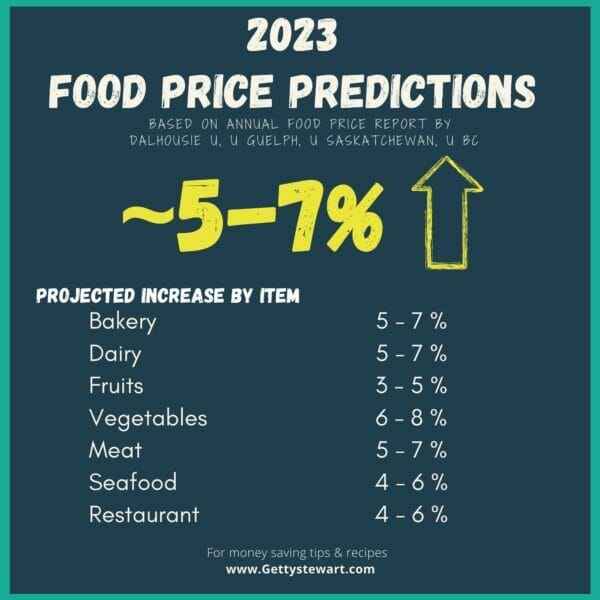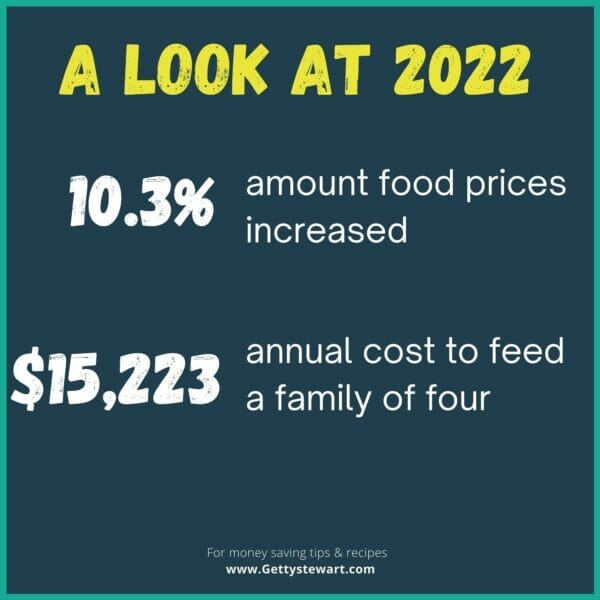Report on Canada’s Food Prices 2023 with Tips for Eating Well
Canada’s Food Price Report 2023 is out. The report, compiled by four Canadian Universities, predicts food prices in 2023 to rise by about 5-7% across the board. Considering the pandemic, current economic, climate, labour, energy prices and war are you surprised?

That’s on top of the 10.3% increase in food prices that happened in 2022! Eating well is getting more and more challenging.

More than anything, I feel for people who are already struggling to put good food on the table. With grocery prices expected keep increasing, meeting healthy eating recommendations set out by Health Canada is
What Were the Stats for 2022?
- last year’s food price report predicted an increase of 5-7%, in reality prices increased by 10.3% due to unforeseen world events
- factors leading to high prices: labour shortages, supply chain disruption, high oil and gas prices, interest rates, climate change, geopolitical events (war in Ukraine)
- is “Greedflation” an issue – are retailers taking advantage of consumers by rising prices by more than the additional costs they’re experiencing? In the fall of 2022, the Competition Board of Canada and the Federal Government indicated they would investigate.

More TidBits
- Food inflation has outpaced general inflation for the last 13 consecutive months.
- The amount of our annual income spent on food has gone from below 10% to close to 20%.
- The average household grocery bill has increased by 170% over the last 20 years.
- In March, visits to Food banks increased by 35% since 2020 – 1.5 million visits in March 2022.
- 57% Canadians say that it is currently difficult to feed their household (Angus Reid Institute, Jan 2022)
- More than 30% of Canadians are eating less healthy food due to rising costs. (Canadian Hub for Applied and Social Research at the University of Saskatchewan)
- Almost 20% are skipping meals to save money on groceries. (Canadian Hub for Applied and Social Research at the University of Saskatchewan)
- People are reaching for more calorie dense, less nutritious food.
- A Canadian household tosses about $1,300 of food every year.
How to Eat Well With Rising Food Prices
Canada’s Food Price Report 2023 lays out what we can expect. Now it’s up to us to figure out how to continue to eat well, even with rising food prices. In addition to smart shopping strategies like taking advantage of sales, coupons, generic brands, discount grocery stores and discount apps, here are a few tips to keep you eating healthy.
1. Make a Meal Plan and Grocery List
Sadly, we often over buy and inadvertently waste food. In fact, the average Canadian household tosses about $1,300 worth of food every year (LoveFoodHateWaste Canada). Making a meal plan and grocery list can help.
It has been proven time and again – when you make a plan and grocery list – you spend less. And you waste less food.
Use this Weekly Meal Planner and Grocery List to plan your weekly grocery needs.
Or Sign up to my monthly meal plans to get premade plans.
2. Use a Combination of Fresh, Frozen and Canned Fruits and Vegetables
Don’t let higher fruit and vegetable prices prevent you from filling Half Your Plate with nutritious produce. To help with the pocket book, shop for frozen and canned fruits and veggies as well as fresh produce. The nutritional content of frozen or canned fruits and vegetables is pretty much equal to and sometimes even better than fresh produce that’s been sitting too long in coolers, transport trucks and warehouses.
If you’re really savvy – buy produce on sale and freeze or preserve them yourself. Learn how in my Guide to Freezing Fruits and Vegetables. Or click in the menu bar to learn how to dehydrate or can produce.
3. Eat Seasonally
You’ll get much more value for your dollar when you buy what’s in season. Look in the menu above for my Seasonal Food section. For each month, I show you the produce that’s in season – that means it’s likely on sale, readily available and at its most flavourful. I also share how to store it, use it and preserve it. Valuable skills for saving money.

4. Eat Your Leftovers & Reduce Food Waste
Don’t toss leftovers or surplus ingredients. Food waste costs the average Canadian household $1,300/year! Make leftovers part of your routine and learn how you can repurpose extra ingredients.
Join me on Instagram or Facebook for daily tips, videos and ideas for how to make full use of your leftovers and produce.
5. Choose Beans, Lentils and other Pulses More Often
They’re nutritious, delicious, affordable and local. Replace some of your meats with these protein alternatives.
Did you know we grow some of the world’s best pulses (dry peas, beans, chickpeas, lentils, etc.) right here on the Canadian prairies. Supporting our local agriculture helps our local economy and helps stabilize prices in the long run. The Manitoba Pulse and Soybean Producers agrees, saying pulses are “one of the most environmentally-friendly sources of protein, contributing to sustainable food production by protecting and improving soil and water resources.”
According to the United Nations, “pulses are a vital source of plant-based proteins and amino acids for people around the globe and should be eaten as part of a healthy diet to address obesity, as well as to prevent and help manage chronic diseases such as diabetes, coronary conditions and cancer; they are also an important source of plant-based protein for animals.”
It’s definitely a good time to add more pulses to our meal planning. Here’s some inspiration and advice on storing and cooking with pulses.
6. Use Your Freezer
If you can’t get to your leftovers right away or see that you have food reaching its Best Before Date – throw it in the freezer not the trash!

Here’s more info on freezing leftovers.
7. Be “Best Before Date” Savvy
With rising food prices on the way, we gotta make the most of every morsel of food we buy. Do not become a sucker for Best Before dates. Just because food has reached the BBD doesn’t mean you have to throw it out. Here are the most important things you need to know about Best Before Dates in Canada.
“Best Before” dates do not guarantee product safety. They provide the manufacturer’s recommendation for the amount of time that an unopened food product under appropriate conditions will keep its freshness, taste and nutritional quality. Think about it, the minute you open your milk jug, the best before date is invalid, so why pay attention to it – use your judgement!

By law, “Best Before” dates and proper storage instructions must appear on pre-packaged foods that will keep fresh for 90 days or less, and are packaged at a place other than the retail store from which they are sold. Items that can be stored for 90 days or more (eg. pasta, nuts, canned goods, etc) do not actually require a Best Before date. Sometimes I wonder if manufacturers are encouraging us to toss and rebuy food by adding Best Before dates – what do you think?
Best Before does not mean Toxic After. Understand best before dates. TWEET This
8. Make More Food From Scratch At Home
According to Canada’s Food Price Report 2021, 70% of us are cooking at home more often since the Pandemic. That’s good news and a good strategy. Cooking at home from scratch is healthier and more affordable.
How confident are you at cooking from scratch, using ingredients you have on hand and stretching food to it’s max? These are the skills that we can improve on to make our food go further.
I want to show you how! Subscribe here and get regular tips and recipes in your inbox!
9. Support Local Growers or Grow & Preserve Your Own Food
And finally, here’s a more long term strategy – support local growers and food producers or grow your own. I get that not everyone can grow or raise their own food, but by supporting local food producers you’re helping to address some of the bigger issues surrounding where and how our food is produced and how that impacts our local economy, climate change and overall food production practices.
For local Farmers’ Markets, farmers that sell directly from their farm and online sales, google: Direct Farms Manitoba
For U-Pick Farms, google: Prairie Fruit Growers Association
For CSA’s (Community Supported Agriculture) delivery options, google: CSA Manitoba.org
For recipes and links to local Manitoba commodity boards, google: Great Tastes of Manitoba
To learn more about initiatives to help fight food insecurity across Manitoba, google: Food Matters Manitoba
This tip isn’t going to save you money right away. It’s a long term investment in the health of you, your family, your local economy and the global environment.

The people that will be hardest hit by rising food prices in Canada are those living on low income where the percent of income spent on food is much higher than for those of us with average to high annual incomes. It will also be a hard hit on those living in Northern or remote communities where food prices are considerably higher than in major urban centres. Ensuring everyone has equal access to good quality food is a challenge for all of us. Food security is everyone’s business. As one participant in a recent workshop on Food Security said “No one is food secure unless their neighbours are food secure.”
Sign up to get articles by Getty delivered to your inbox. You’ll get recipes, practical tips and great food information like this. Getty is a Professional Home Economist, speaker and writer putting good food on tables and agendas. She is the author of Manitoba’s best-selling Prairie Fruit Cookbook, Founder of Fruit Share, a mom and veggie gardener.

